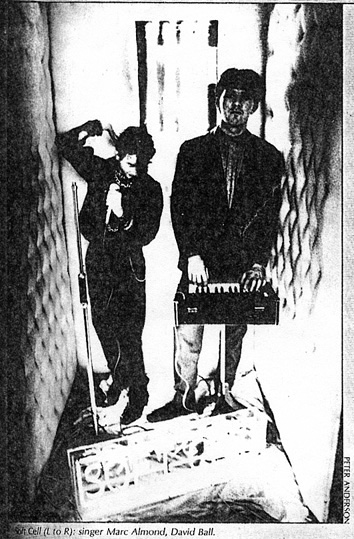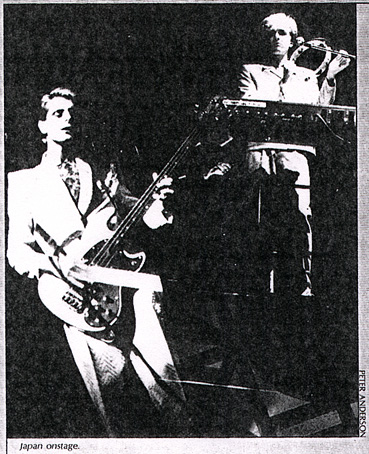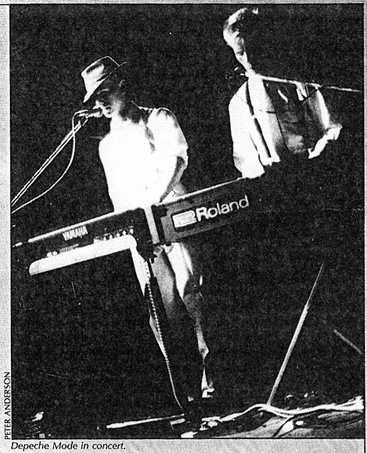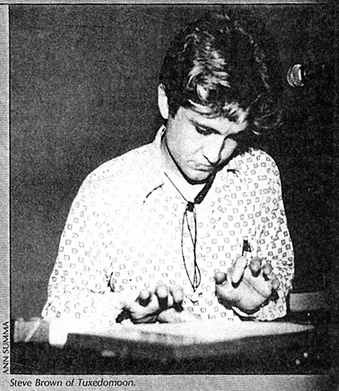The New Synthesizer Rock
Keyboard Magazine, June 1982
pgs. 11-18
 THE
NEW WAVE HAS CRESTED. THE
NEW WAVE HAS CRESTED. About five years ago it began surging across the then watery musical landscape, stinging audiences that had been lulled by MOR and disco with its sharp cold spray. Suddenly the established stars of rock looked a little older, prematurely graying in their late 20s before the onslaught of groups like Blondie, Devo, Talking Heads, and Elvis Costello. Hard to believe it all happened half a decade back. For keyboard-playing fans of progressive rock, still scuffling for bits of news about Keith Emerson and reprogramming nostalgic orchestral synthesizer effects, the following news may be even more unsettling: New wave is dead. Already, Elvis Costello is singing duets with George Jones, Blondie is dabbling in conceptual albums, and in their footsteps new younger players are experimenting, exploring, grabbing for a place at the cutting edge of modern rock. In a way, it's all predictable. Rock is a constantly regenerating phenomenon. When one generation of artists gets a little too flabby, or starts straying a bit too far from the basics of the music, it gets elbowed aside by impatient newcomers, eager to get back to the sound, beat, and the stance of rock at its simplest. A mellow Elvis Presley, tamed by the Army, led to the Beatles, whose successive cuteness and artsiness stimulated the psychedelic movement, in whose burned-out ashes the anti-romantic seeds of punk were sewn. But while styles change, while the cycle spins on, the tools stay roughly the same. Rock means guitars, drums, and, thankfully, keyboards of one sort or another. The current revival of essential rock involves, if anything, a greater use of keyboards than any similar return to rock roots. But in almost every other aspect, a refugee from the '60s or even the mid-'70s would find huge differences between the rock of those days and what is happening now This means, in turn, that the use and function of keyboards, especially synthesizers, has undergone some breathtaking changes in the journey from Tomita to Deutsch-Amerikanische Freundschaft. THE NEW by bob doerschuk SYNTHESIZER ROCK |
Page 12:
 What many post-new wave bands have in common with earlier stripped down rock groups is an interest in playing more for dancers than for listeners. Where older acts as diverse as the Who and Styx tend to appear before sedentary, sometimes demurely seated, crowds in stadiums and vast concert halls, performances by Orchestral Manoeuvers In The Dark, Depeche Mode, and their brethren usually work best in the more traditional rock setting-hot sticky clubs jammed wall to wall with bodies leaping about to an irresistible 4/4 rhythm. These new bands pursue a familiar formula-heavy on the second and fourth beats, with compelling counter-rhythms from the bass and as little adornment as possible. In short, the tried-and-true rock and roll blueprint. In fact, their subservience to the beat is more complete than was the case with Little Richard, Creedence Clearwater, and other oldies, because of the disco influence. Most disco records center around the drums, in some cases almost exclusively the bass drum, with orchestras, guitars, and everything else except vocals mixed down to nearly a subconscious level. Although the ideology of the music hasn't much relevance to the young synth rockers, they are children of a radio era that has saturated the airwaves, street corners, and brain cells with disco's merciless pulse. Inevitably, this has had its impact; even the dreariest, most nihilistic lyrics shout out in post-new wave ensembles over a bedrock beat that should set the most danced-out feet tapping. But though the the lyrical focus differs, with disco composers seldom searching beyond sex and neo-wavers often dipping into anger and alienation for inspiration, the impact on dancers is nearly identical. Both Donna Summer and Soft Cell's Marc Almond have an ability to project a kind of detached desperation through their vocals, but much of that projection is due to the hypnotic power of the unsyncopated repetitive electronic riffs over which they sing. To further the effect, many new bands have turned from live drummers to rhythm machines, which allow for unvarying sequences of identical percussion sounds and eliminate any possibilities of trance-breaking irregularities in the less dependable hands of human drummers. Some groups, like Orchestral Manoeuvers, do use drummers on-stage, though even then the impact of electronic rhythm units can be heard in the steady beat the drummers are assigned. But more frequently, in the work of Soft Cell, the Human League. Throbbing Gristle, Tuxedomoon, and the now defunct Suicide, digital boxes have replaced trap sets. |
Sound
familiar? This is the approach pioneered by the German techno-rockers
Kraftwerk (see Keyboard, March '82). Their straight forward beat, minimalist
textures, and use of pointy razor-edged synthesizer sounds awakened many
young keyboardists to the fact that keyboard electronics did not necessarily
have to follow the color-washed soft-focus footsteps of Tomita or Jean-Michel
Jarre. Any consideration of the new style must acknowledge Kraftwerk,
especially in their fusion of disco and techno, as the the movement's
musical godfathers. Of course there are other branches in the music's family tree. Spiritually, the lineage stretches back to the early '50s. In its pure state, rock and roll has always been iconoclastic, with certain inseparable and generally antiestablishment connotations. Little Richard's manic antics were beyond the comprehension of the adult world in the Eisenhower era; the fact that white kids listened to black music let alone music played by a black man wearing mascara and suggestively writhing all over a piano keyboard, caused more dinner table anxiety than the prospect of nuclear war. As society loosened up in the liberal '60s, rock performers had to probe further in into the dark corners of parental fear for equivalent effect. The faint hint of androgyny in the Beatles, the delinquent scruffiness of the Rolling Stones, the flamboyant communism of the Haight-Ashbury bands, all measured this escalating assault on grown-up standards. But when the heavy artillery rolled out by groups like the Doors, the Fugs, the Velvet Underground, the New York Dolls, and the MC5-groups that cultivated vaguely occult, sleazy, anarchistic, and/or sexually bizarre facades-anti establishment posturing began to become fine art. The music had finally hit America's funny bone. Shock rock was born. Image-wise, the ramifications are still being felt today. In traditional showbiz, performers smile, laugh, and dance for the audience. Because of the shock rock ethic, these entertainment techniques are frequently abandoned by bands who get their energy by mobilizing their audience's instincts for rebellion. The problem is that it can get difficult to draw the line between image and reality; no doubt many old-time vaudevillians were genuinely happy people, and as the Sid Vicious and Joy Division legacies demonstrate, many shock rockers seem to be genuinely strange as well. But it would be a mistake to dismiss the new bands as pure shock rockers. A close listen to the best of their work reveals a growing musical sensibility, a feeling for orchestration and linear compositions, and an overall discipline frequently absent in the best of some highly regarded progressive rock artists. The singers may appear to wrestle with the ideas of pitch and melody, but this is a stylistic issue just as early jazz singers dismayed oldsters with their neo-African melisma, so might today's Barry Manilow fans be distressed by the emotional yowls of Jim Morrison's and Johhny Rotten's vocal progeny. More to the point for us is the keyboard work. One characteristic of many new bands is how they build tension between the singing and the synthesis. Like Morrison in "The End," Soft Cell's Marc Almond conjures chilling images in a tortured wailing delivery, but where the doors supported Morrison's excursions with their own improvisations, David Ball lays down meticulous patterns designed to highlight through contrast, rather than to complement, the singer. A similar approach underscores the more anarchic efforts of Throbbing Gristle and New Order; the distance between cathartic vocals and restrained, even rigid, electronic accompaniment can create a powerful effect. If follows, then, that technical virtuosity is not an especially relevant attribute in this style. Since much of the impact of neo wave synthesis stems from machine-like repetition - a technique also employed by the equivalent anti-romantics in classical music, the minimalists - the keyboard flourishes of the Keith Emerson school would be definitely out of place in this context. Solos in the traditional sense, improvisations realized on the keyboard, are a rarity; at most you might find occasional four-bar single-line passages, more fills than solos, such as at the end of the Units' "Bugboy." |
Page 13:
| Instead,
the focus shifts to the arrangement. The droning organ sounds and underplayed
fills of Ray Manzarek in The Doors and John Cale in the Velvet
Underground's "Heroin" are the real rock antecedents of the new synthesists.
Like Manzarek and Cale - both technically adept keyboardists - they are
more interested on integrating into the whole than in standing out front.
This attitude is also reflected in the early work of Jimmie Destri with
Blondie and Steve Naive with Elvis Costello's Attractions, the most prominent
figures in the new wave revival of Farfisa and Vox organ sounds. But aside
from a few adherents here and there, among them Joe "King" Carrasco, the
Insect Surfers, and Tex-Mex nostalgists like Augie Meyer of the Sir Douglas
Quintet, most new keyboardists who want old-timey electric organ effects
find it easier to store them into their synthesizers as one of an array
of possible programs. The fact is that the neo-wavers are just as concerned as Tony Banks or Patrick Moraz with orchestrated sound, but they tend to work from the background. Even when Wakeman is only laying down synthesized strings, he does so with such panache that there is no mistaking his identity. His younger counterparts prefer sublimating themselves to the beat, inserting short riffs or patterns of subtly contrasting colors. Case in point: the tiny tonal variations in the riff that constitutes DAF's "Liebe Auf Dem Ersten Blick," from Gold und Liebe. If you want to listen, you must listen carefully to appreciate synthesist Robert Gorl's meticulous touch. But if you want to dance instead, you can do that too. And so the cycle is once again completed. For listeners who are used to sitting back and letting orchestral synthesized chords or a string of lightening-bolt licks to wash over them, neo wave synthesis may be an acquired taste. But once again something different is happening to rock, and as the first swing back to basics in the synthesizer era, there is as much in it for the head as there is for the feet. Partly because of the relatively low-key roles they lean toward, there are no superstars, no Hendrixes or Emersons, among the young synthesists. Their bands have followings, but sometimes the most devoted fans have trouble remembering the names of the players whose records they consume. This is true especially in the States, since many pioneering neo wave groups are English, and some of the most important of these have never played any American engagements. For this reason, Keyboard indulged itself in a series of trans-Atlantic phone interviews with some of the leading lights in this still fresh movement. [Ed. Note: For full-length articles on other important keyboardists in this area, see our interviews with Billy Currie of Ultravox, Jan. '82, Kraftwerk, Mar. '82, and Orchestral Manoeuvers In The Dark, Apr. '82]. We also talked to the keyboardists in three American bands whose work ties in with that of the European pioneers. While no two of the artists in the following assembled interviews should be considered clones of one another or anyone else, they all share at least one thing in common: an interest in using the synthesizer in rock as it's never been used before, in part to get back to where the music in its essence belongs. Some of the people we spoke with - Martin Gore of Depeche Mode, Layne Rico and Scott Simon of Our Daughters Wedding - are close to the mainstream of pop music, using rhythm machines and sequencers to pound out a disco-derived dance beat. Others - Scott Ryser and Rachel Webber of the Units, David Ball of Soft Cell - also adhere to a steady rhythm, but with darker overtones more clearly reminiscent of punk and new wave, while Richard Barbieri of the English group Japan, Chas Gray and Stan Ridgeway of Wall of Voodoo, and Peter Principle of Tuxedomoon all shy from the tyranny of the sequencer and pursue freer forms in their own ways. What it goes to show is the even at this early stage of its development, the new rock synthesizer vanguard is branching beyond stereotypes and finding room to create in ways unforeseen by the rock trendsetters a decade ago.
* * * *
LET'S BEGIN BY find out about your musical backgrounds. Did you take a lot of piano lessons, for example, or were you mainly self-taught? Richard Barbieri (Japan): I was self-taught, really. I was never taught how to play by anyone, and I didn't start off on the piano. I've never felt comfortable with acoustic piano. It was really only when I started using synthesizers that I felt I could be useful and do something interesting, or put over what I wanted to do. |
 Had you had any electronic music experience before you got into synthesizers? Barbieri: Not really, no it was a very naive kind of thing. I just started, and carried on from there. I was just lucky that I had the right people around me from whom I could gain influences and who I could influence in turn, and that's really how Japan came about. I joined probably six months after the band was formed. We're all self-taught. I'd say there's probably only one real musician in the band - Steve Jansen, the drummer. Scott Ryser (the Units): We got together about three years ago. Rachel and I met at a Tuxedomoon concert at the Mab [Mabuhay Gardens, a San Francisco club]. We were both hauling some equipment for them, and we just got to talking. It turned out that Rachel was doing an experimental performance in the windows at the abandoned J. C. Penney building downtown. We wound up collaborating. Rachel painted the windows black from the inside, and as I played some synthesizer music while films were being shown, she'd gradually scrape the stuff off the windows so people could start peeping in. Were you both visual artists before getting into music? Rachel Webber (the Units): I was, but Scott has more of a background in synthesizer. He bought the first synthesizer to come into San Francisco. I started singing with Scott, then I ended up playing synthesizer too because it was more gratifying to help write music. Layne Rico (Our Daughters Wedding): We also started off as friends in the San Francisco Bay area. About two years ago we had a band that was similar to the Cars, a rock-style guitar band We had no synthesizers at the time, but finally we incorporated a couple of keyboard players - Scott [Simon] and someone else. Then we got tired of that guitar-drum lineup, so we all moved to New York, I traded my drum kit for the new percussion synthesizers, and Keith[Silva], the lead vocalist, dropped his guitars and learned to play keyboards. We thought that would be more interesting, because most of the music we were listening to at the time was, more or less electronic, European things that American bands weren't playing. Martin Gore (Depeche Mode): When we got rid of our guitar players, it was mainly because we didn't have any transport at the time. We had to get one of our friends to take us everywhere in a van, and it was very difficult to get in touch with him all the time. It was far easier for us to just play synths, because they are very portable. Everywhere we played we just showed up with our synths in suitcases, then hired a PA and played through it. |
Page 14:
| But
wasn't there also a musical reason for scrapping the guitars? Gore: The guitars were getting rather boring. They've got just one sound all the time, and though you can flange it and do things like that; its still basically the same sound. David Ball(Soft Cell): I originally started with guitars but I got board because there really wasn't much you could do with it. I was interested in different types of sound, so I got rid of the guitar and got a synthesizer. Was Soft Cell always a duo, as it is today? Ball:We did start out as a duo. Mark (Almond, singer) and I started working together in 1979, when we were both in college at Leeds. Mark was in a performance that was more like cabaret, and I was doing soundtracks with him. Then we decided to do something more commercial. We came up with about ten songs and played our first gig in the autumn of 1979. Chas Gray (Wall Of Voodoo): We also started out doing soundtracks. Stan, our guitar player, Marc Moreland, and I rented an office off Hollywood Blvd. in late'77 specifically to do film soundtracks. We had a couple of two-track tape recorders, a file cabinet, a desk, and a light - no typewriter, and we were kind of low on clients too. But we made a lot of tapes. Stan Ridgway (Wall Of Voodoo): Eventually, the company turned into a band. Were the instruments you used on the soundtracks similar to what you later used onstage? Ridgway: Not really. Onstage there's so much you have to do, but when you have the freedom of tape You can do a lot of manipulation with acoustic or electric sounds. We used to specialize in slowed-down or sped-up tapes sandwiched in between real-time stuff, because we couldn't really play fast enough on the keyboards to get the speed we needed. We used to play it at a comfortable tempo, then get it faster on another track, and it sounded pretty good. Do you feel that your experience with soundtracks gave you any insights with synthesizers that you might otherwise have lacked? Ridgway: Well, we always felt that music was for generating moods, and trying to play fast in a virtuoso type of thing wasn't something we were interested in. We were more interested in a feel that had nothing to do with musicianship. Do you feel that keyboard virtuosity is not as important to now styles of synthesizer playing as it was in the past? Ridgeway: Yeah, and I think I understand why. When the synthesizer first came out, it was looked upon pretty much as a crazy organ. You had players like Chick Corea and Jan Hammer trying to make it sound like a guitar. But in formal music people had been using the instrument for a long time before that, and it just took some time for the two ideas to catch up with one another. Barbieri: I think people tend to use synthesizers in a more subtle way now. Ball: The technical skill now lies in actually programming the synthesizer, rather than in playing the keyboard. I think of synthesizer players as keyboardists, actually. There are keyboard players who play piano and organ, and there are synthesizer players who are more like technicians. Of course there are really good piano players who can do great things on synthesizers too. Ryser: It's more a matter of good taste now, or just generally being creative. I don't think it's as necessary as it used to be to have lots of impressive licks. Some of these new synthesizers, like Sequential Circuits Pro-One, will play arpeggios for you. My sequencer is Sequential Circuits too, and I can program it at a snail's pace then just speed it up to whatever tempo I want. In that sense, you really differ from the bands of the '60s, with their extended solos. Ryser: Yeah. It's more important to me to contribute to the sound or the band than to play a solo. When any of us do solo, it's more to create a dialog between the instruments, as opposed to just sticking one player out in front. Simon: Exactly. Solos should be pertinent to the vocal line and the message you're trying to get across. When you have singing involved, belaboring an instrumental section just takes away from the song. And the kids get a little bored, even if someone is excellent on an instrument, all the licks start to sound the same if it goes on and on. |
 Ryser: In the '60s people got outside of the structure more, and now it's a thing of getting back into the structure, making the players in the group work really work together Simon: As soon as synthesizers came along, everyone said, "oh, wow, outer space!" and that type of thing. That lasted until the players matured, and then synth started to take on a different meaning: horn lines, guitar lines, background noise, or what have you, rather than the Keith Emerson "Lucky Man" standard glide. What are your thoughts now about people like Emerson and Rick Wakeman? Simon: They were very good keyboard players, that stands by itself. Ryser: For my part, I think my style is a reaction against guys like Emerson and Wakeman. When they first came out, I really liked them, but after a while it got too pretentious. Ball: I really used to hate the kind of things they were doing, because it was just impressing people by how fast they could play a riff. To me, that doesn't mean anything. There's no feeling there; it's just technical brilliance. Is having that kind of technical skill in any way a liability in your music? Principle: No, not at all. I couldn't imagine anything that would be a liability if it comes talent. Its not what you have, but the way you use what you have, that makes good art. Ridgeway: But in a lot of ways I think having a knowledge of music has helped us out a lot more than having a knowledge of the keyboard. It's interesting to be talking to a keyboard magazine, because we never really considered ourselves keyboardists at all. Yet there is a lot of synthesizer on your albums. Ridgeway: I know, but it's still funny. We've played them, but our area of expertise is different. The idea of a monophonic synthesizer, where one note is played at opened up a whole different approach to the keyboard. For centuries, the keyboardist was a two-handed thing. You worked in an orchestral sense. Then when a keyboard came along that was just a trigger to generate sounds out of a synthesizer, that completely changed things. Gore: When you use a lot of sequencers and things like that, you don't really need much technical playing ability. But you still need some sort of know-how, some sort of musical knowledge to know what sounds right. When a note sounds wrong, you should know how to change it accordingly. When people talk about just leaving a sequencer running to finish a song, it's not that simple. Ball: Groups that are dominated by sequencers I find a little boring, actually. I think a lot of people are possessed with the idea that because machines can do that kind of thing you've got to let them steal the limelight. Those people seem to be into the idea that the medium is the message. Kraftwerk is the perfect example. |
Pages 15-18